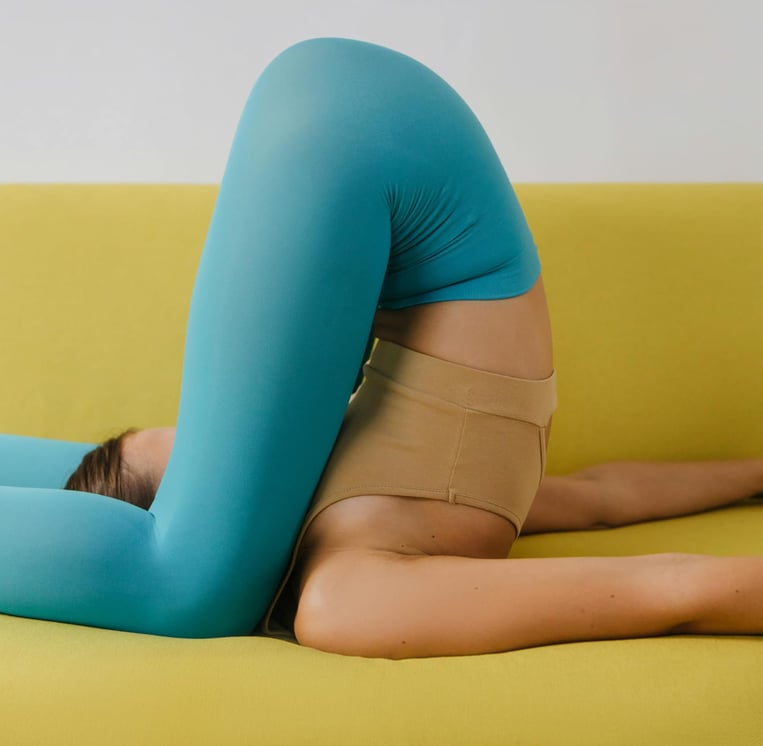
Prevention of diseases from Ear Pressure Pose
Benefits, Technique and Precautions for Karnapidasana (Ear Pressure Pose) also know prevention of diseases from Ear Pressure Pose or Karnapidasana and safety tips.


Karnapidasana (Ear Pressure Pose)
is a calming yoga posture that provides a deep stretch for the back, neck, shoulders, and hamstrings. It also helps improve circulation, reduce stress, and calm the mind.
Steps to Perform Karnapidasana
1. Begin in Halasana (Plow Pose):
Lie flat on your back.
Lift your legs over your head, bringing them toward the floor behind you until your toes touch the ground.
2. Move into Karnapidasana:
Bend your knees and bring them down towards your ears, placing them on the floor.
Rest your knees lightly on each side of your head or as close as possible.
Place your arms flat on the floor alongside your body, or if comfortable, clasp your hands behind your back for a deeper stretch.
3. Focus on Breathing:
Close your eyes and take slow, deep breaths.
Stay in this position for 5-10 breaths, or as long as comfortable, allowing yourself to relax and feel the stretch along your spine and shoulders.
4. To Release the Pose:
Gently straighten your legs back into Halasana.
Slowly roll your spine down to the mat one vertebra at a time until you are lying flat.
Benefits of Karnapidasana
Stretches the spine, shoulders, and hamstrings.
Relieves tension in the neck and back.
Helps to calm the mind, reducing stress and anxiety.
Stimulates the thyroid gland, improving metabolism.
Improves circulation and promotes relaxation.
Prevention of Diseases:
Karnapidasana, also known as the "Ear Pressure Pose," is a yoga asana that provides numerous benefits for the body and mind. While it doesn't directly "prevent" diseases, regular practice can enhance overall health and help mitigate risk factors associated with certain conditions. Here's a breakdown of the potential benefits:
1. Improves Spinal Health
Prevention of Spinal Issues: By stretching and lengthening the spine, Karnapidasana promotes flexibility and reduces the risk of back pain, sciatica, and other spinal disorders.
2. Boosts Circulatory Health
Prevention of Cardiovascular Problems: Inversions like Karnapidasana encourage blood flow to the upper body, reducing strain on the heart and improving circulation.
3. Supports Nervous System Health
Reduction in Stress-Related Conditions: The calming effect on the nervous system may help prevent anxiety, depression, and stress-induced illnesses such as hypertension and migraines.
4. Aids Digestive Health
Prevention of Digestive Disorders: The compression of the abdominal region stimulates digestive organs, improving digestion and preventing issues like constipation and indigestion.
5. Strengthens Immune System
Reduced Risk of Illnesses: Enhanced blood flow and relaxation may improve immune response, helping to fend off common infections.
6. Improves Endocrine Function
Balance in Hormonal Disorders: By stimulating the thyroid and parathyroid glands, it can help maintain hormonal balance and prevent disorders like hypothyroidism.
7. Enhances Muscular Flexibility
Prevention of Muscular Stiffness and Pain: Regular practice increases flexibility in the hips, shoulders, and legs, reducing the risk of joint or muscular injuries.
8. Promotes Mental Clarity
Prevention of Cognitive Decline: The asana helps increase blood flow to the brain, enhancing focus and potentially delaying age-related cognitive decline.
9. Supports Respiratory Health
Prevention of Breathing Issues: The pose facilitates deeper breathing, strengthening the lungs and reducing the risk of respiratory problems like asthma.
Precautions
Avoid this pose if you have neck or back injuries.
Practice with caution if you have high blood pressure.
Beginners may benefit from using props, like a folded blanket under the shoulders, to support the neck.
This asana is excellent for enhancing flexibility and encouraging mindfulness, making it a valuable addition to any yoga practice
Disclaimer: Before beginning any yoga practice, it is advisable to consult a healthcare professional, especially if you have any pre-existing medical conditions, injuries, or concerns. Yoga involves physical movement that may not be suitable for everyone, and a medical professional can help determine if these practices are appropriate for you. The information provided here is for educational purposes and is not a substitute for professional medical advice, diagnosis, or treatment. Practice mindfully and listen to your body to ensure safety and well-being.
